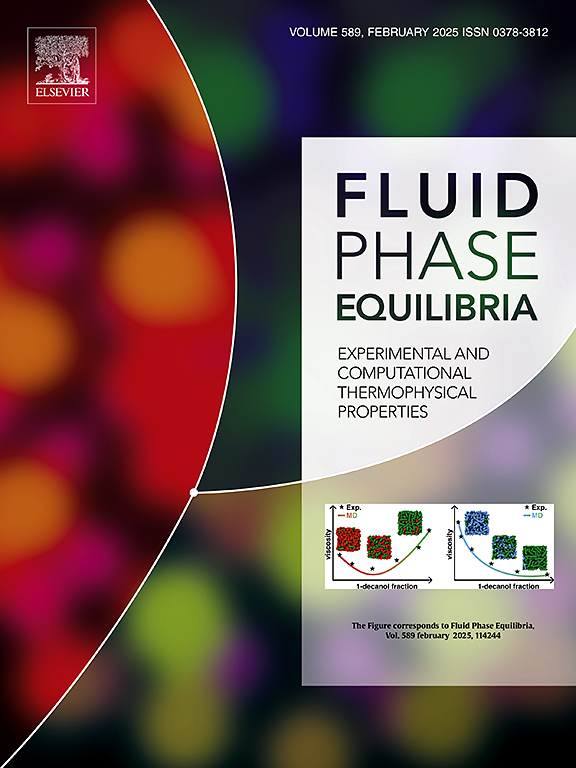Thermodynamic modeling of sugars solubility in pure and mixed solvents using the perturbed hard sphere chain equation of state
IF 2.8
3区 工程技术
Q3 CHEMISTRY, PHYSICAL
引用次数: 0
Abstract
In this work, the Perturbed Hard Sphere Chain (PHSC) equation of state (EoS) has been utilized to model the solubility of sugars in pure and mixed solvents. In this regard, thirteen sugars containing glucose, fructose, xylose, maltose, mannitol, mannose, sorbitol, xylitol, galactose, erythritol, maltitol, trehalose, and sucrose have been considered. The model parameters have been optimized using a binary sugar-water equilibrium data at an arbitrary temperature. The solubilities of sugars in water and alcohols at various temperatures have been predicted using the obtained model parameters. The average AAD% value of sugar solubility in pure solvents has been obtained 0.98%. The model was also applied to predict the solubility of sugars in mixed solvents without using additional adjustable parameters. The results show that the PHSC EoS can predict the solubility of sugars in mixed solvents up to high concentrations accurately. The average AAD% value of the ternary sugar-water-alcohol system has been obtained 6.5%. The results show that the PHSC EoS can be used as a robust thermodynamic model to predict the solubilities of sugars in mixed solvents up to high concentrations and various temperatures accurately.

用微扰硬球链状态方程模拟糖在纯溶剂和混合溶剂中的溶解度
在这项工作中,摄动硬球链(PHSC)状态方程(EoS)被用来模拟糖在纯溶剂和混合溶剂中的溶解度。在这方面,已经考虑了13种糖,包括葡萄糖、果糖、木糖、麦芽糖、甘露醇、甘露糖、山梨醇、木糖醇、半乳糖、赤藓糖醇、麦芽糖醇、海藻糖和蔗糖。利用任意温度下的糖水二元平衡数据对模型参数进行了优化。利用得到的模型参数,预测了糖在不同温度下在水和醇中的溶解度。所得糖在纯溶剂中的溶解度平均AAD%值为0.98%。该模型也被用于预测糖在混合溶剂中的溶解度,而不使用额外的可调参数。结果表明,PHSC - EoS可以准确预测糖在高浓度混合溶剂中的溶解度。得到糖-水-醇三元体系的平均AAD%值为6.5%。结果表明,PHSC - EoS可以作为一个稳健的热力学模型,准确预测糖在不同浓度和温度下的混合溶剂中的溶解度。
本文章由计算机程序翻译,如有差异,请以英文原文为准。
求助全文
约1分钟内获得全文
求助全文
来源期刊

Fluid Phase Equilibria
工程技术-工程:化工
CiteScore
5.30
自引率
15.40%
发文量
223
审稿时长
53 days
期刊介绍:
Fluid Phase Equilibria publishes high-quality papers dealing with experimental, theoretical, and applied research related to equilibrium and transport properties of fluids, solids, and interfaces. Subjects of interest include physical/phase and chemical equilibria; equilibrium and nonequilibrium thermophysical properties; fundamental thermodynamic relations; and stability. The systems central to the journal include pure substances and mixtures of organic and inorganic materials, including polymers, biochemicals, and surfactants with sufficient characterization of composition and purity for the results to be reproduced. Alloys are of interest only when thermodynamic studies are included, purely material studies will not be considered. In all cases, authors are expected to provide physical or chemical interpretations of the results.
Experimental research can include measurements under all conditions of temperature, pressure, and composition, including critical and supercritical. Measurements are to be associated with systems and conditions of fundamental or applied interest, and may not be only a collection of routine data, such as physical property or solubility measurements at limited pressures and temperatures close to ambient, or surfactant studies focussed strictly on micellisation or micelle structure. Papers reporting common data must be accompanied by new physical insights and/or contemporary or new theory or techniques.
 求助内容:
求助内容: 应助结果提醒方式:
应助结果提醒方式:


